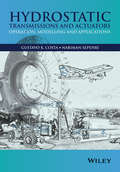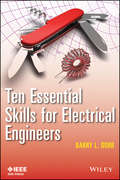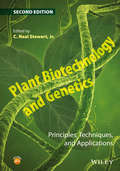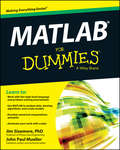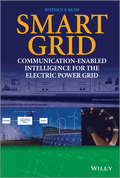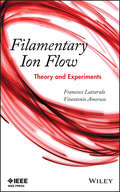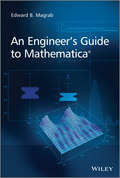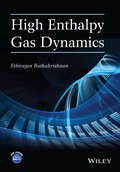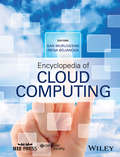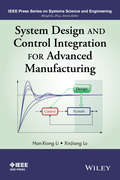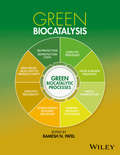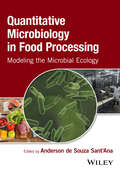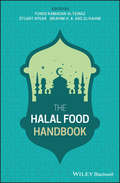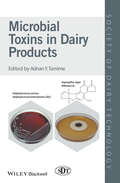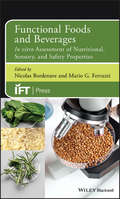- Table View
- List View
Hydrostatic Transmissions and Actuators: Operation, Modelling and Applications
by Gustavo Costa Nariman SepehriHydrostatic Transmissions and Actuators takes a pedagogical approach and begins with an overview of the subject, providing basic definitions and introducing fundamental concepts. Hydrostatic transmissions and hydrostatic actuators are then examined in more detail with coverage of pumps and motors, hydrostatic solutions to single-rod actuators, energy management and efficiency and dynamic response. Consideration is also given to current and emerging applications of hydrostatic transmissions and actuators in automobiles, mobile equipment, wind turbines, wave energy harvesting and airplanes. End of chapter exercises and real world industrial examples are included throughout and a companion website hosting a solution manual is also available. Hydrostatic Transmissions and Actuators is an up to date and comprehensive textbook suitable for courses on fluid power systems and technology, and mechatronics systems design.
Hydrostatic Transmissions and Actuators: Operation, Modelling and Applications
by Gustavo Costa Nariman SepehriHydrostatic Transmissions and Actuators takes a pedagogical approach and begins with an overview of the subject, providing basic definitions and introducing fundamental concepts. Hydrostatic transmissions and hydrostatic actuators are then examined in more detail with coverage of pumps and motors, hydrostatic solutions to single-rod actuators, energy management and efficiency and dynamic response. Consideration is also given to current and emerging applications of hydrostatic transmissions and actuators in automobiles, mobile equipment, wind turbines, wave energy harvesting and airplanes. End of chapter exercises and real world industrial examples are included throughout and a companion website hosting a solution manual is also available. Hydrostatic Transmissions and Actuators is an up to date and comprehensive textbook suitable for courses on fluid power systems and technology, and mechatronics systems design.
Ten Essential Skills for Electrical Engineers (Wiley - IEEE)
by Barry L. DorrThe book is a review of essential skills that an entry-level or experienced engineer must be able to demonstrate on a job interview and perform when hired. It will help engineers prepare for interviews by demonstrating application of basic principles to practical problems. Hiring managers will find the book useful because it defines a common ground between the student's academic background and the company's product or technology-specific needs, thereby allowing managers to minimize their risk when making hiring decisions. Ten Essential Skills contains a series of "How to" chapters. Each chapter realizes a goal, such as designing an active filter or designing a discrete servo. The primary value of these chapters, however, is that they apply engineering fundamentals to practical problems. The book is a handy reference for engineers in their first years on the job. Enables recent graduates in engineering to succeed in challenging technical interviews Written in an intuitive, easy-to-follow style for the benefit of busy students and employers Book focuses on the intersection between company-specific knowledge and engineering fundamentals Companion website includes interview practice problems and advanced material
Plant Biotechnology and Genetics: Principles, Techniques, and Applications
by C. Neal StewartFocused on basics and processes, this textbook teaches plant biology and agriculture applications with summary and discussion questions in each chapter. Updates each chapter to reflect advances / changes since the first edition, for example: new biotechnology tools and advances, genomics and systems biology, intellectual property issues on DNA and patents, discussion of synthetic biology tools Features autobiographical essays from eminent scientists, providing insight into plant biotechnology and careers Has a companion website with color images from the book and PowerPoint slides Links with author's own website that contains teaching slides and graphics for professors and students: http://bit.ly/2CI3mjp
Plant Biotechnology and Genetics: Principles, Techniques, and Applications
by C. Neal StewartFocused on basics and processes, this textbook teaches plant biology and agriculture applications with summary and discussion questions in each chapter. Updates each chapter to reflect advances / changes since the first edition, for example: new biotechnology tools and advances, genomics and systems biology, intellectual property issues on DNA and patents, discussion of synthetic biology tools Features autobiographical essays from eminent scientists, providing insight into plant biotechnology and careers Has a companion website with color images from the book and PowerPoint slides Links with author's own website that contains teaching slides and graphics for professors and students: http://bit.ly/2CI3mjp
MATLAB For Dummies
by Jim Sizemore John Paul MuellerPlot graphs, solve equations, and write code in a flash! If you work in a STEM field, chances are you'll be using MATLAB on a daily basis. MATLAB is a popular and powerful computational tool and this book provides everything you need to start manipulating and plotting your data. MATLAB has rapidly become the premier data tool, and MATLAB For Dummies is a comprehensive guide to the fundamentals. MATLAB For Dummies guides you through this complex computational language from installation to visualization to automation. Learn MATLAB's language fundamentals including syntax, operators, and data types Understand how to use the most important window in MATLAB – the Command Window Get the basics of linear algebra to get up and running with vectors, matrices, and hyperspace Automate your work with programming scripts and functions Plot graphs in 2D and 3D to visualize your data Includes a handy guide for MATLAB's functions and plotting routines MATLAB is an essential part of the analysis arsenal and MATLAB For Dummies provides clear, thorough guidance to get the most out of your data.
Smart Grid: Communication-Enabled Intelligence for the Electric Power Grid (Wiley - IEEE)
by Stephen F. BushThis book bridges the divide between the fields of power systems engineering and computer communication through the new field of power system information theory. Written by an expert with vast experience in the field, this book explores the smart grid from generation to consumption, both as it is planned today and how it will evolve tomorrow. The book focuses upon what differentiates the smart grid from the "traditional" power grid as it has been known for the last century. Furthermore, the author provides the reader with a fundamental understanding of both power systems and communication networking. It shows the complexity and operational requirements of the evolving power grid, the so-called "smart grid," to the communication networking engineer; and similarly, it shows the complexity and operational requirements for communications to the power systems engineer. The book is divided into three parts. Part One discusses the basic operation of the electric power grid, covering fundamental knowledge that is assumed in Parts Two and Three. Part Two introduces communications and networking, which are critical enablers for the smart grid. It also considers how communication and networking will evolve as technology develops. This lays the foundation for Part Three, which utilizes communication within the power grid. Part Three draws heavily upon both the embedded intelligence within the power grid and current research, anticipating how and where computational intelligence will be implemented within the smart grid. Each part is divided into chapters and each chapter has a set of questions useful for exercising the readers' understanding of the material in that chapter. Key Features: Bridges the gap between power systems and communications experts Addresses the smart grid from generation to consumption, both as it is planned today and how it will likely evolve tomorrow Explores the smart grid from the perspective of traditional power systems as well as from communications Discusses power systems, communications, and machine learning that all define the smart grid It introduces the new field of power system information theory
Smart Grid: Communication-Enabled Intelligence for the Electric Power Grid (Wiley - IEEE)
by Stephen F. BushThis book bridges the divide between the fields of power systems engineering and computer communication through the new field of power system information theory. Written by an expert with vast experience in the field, this book explores the smart grid from generation to consumption, both as it is planned today and how it will evolve tomorrow. The book focuses upon what differentiates the smart grid from the "traditional" power grid as it has been known for the last century. Furthermore, the author provides the reader with a fundamental understanding of both power systems and communication networking. It shows the complexity and operational requirements of the evolving power grid, the so-called "smart grid," to the communication networking engineer; and similarly, it shows the complexity and operational requirements for communications to the power systems engineer. The book is divided into three parts. Part One discusses the basic operation of the electric power grid, covering fundamental knowledge that is assumed in Parts Two and Three. Part Two introduces communications and networking, which are critical enablers for the smart grid. It also considers how communication and networking will evolve as technology develops. This lays the foundation for Part Three, which utilizes communication within the power grid. Part Three draws heavily upon both the embedded intelligence within the power grid and current research, anticipating how and where computational intelligence will be implemented within the smart grid. Each part is divided into chapters and each chapter has a set of questions useful for exercising the readers' understanding of the material in that chapter. Key Features: Bridges the gap between power systems and communications experts Addresses the smart grid from generation to consumption, both as it is planned today and how it will likely evolve tomorrow Explores the smart grid from the perspective of traditional power systems as well as from communications Discusses power systems, communications, and machine learning that all define the smart grid It introduces the new field of power system information theory
Filamentary Ion Flow: Theory and Experiments
by Francesco Lattarulo Vitantonio AmorusoPresents all-new laboratory-tested theory for calculating more accurate ionized electric fields to aid in designing high-voltage devices and its components Understanding and accurately calculating corona originated electric fields are important issues for scientists who are involved in electromagnetic and electrostatic studies. High-voltage dc lines and equipment, in particular, can generate ion flows that can give rise to environmental inconveniences. Filamentary Ion Flow: Theory and Experiments provides interdisciplinary theoretical arguments to attain a final model for computational electrostatics in the presence of flowing space charge. Based on years of extensive lab tests pertaining to the physical performance of unipolar corona ion flows, the book covers the enlarging of conventional electrostatic applications, which allows for some emerging and uncharted interests to be explored. Filamentary Ion Flow: Examines the theoretical discussions for creating a model of computational electrostatics involved with flowing space charges Presents new theory and experimental data based on extensive testing Offers potential design applications utilizing the theory Helps scientists who are involved in electromagnetic and electrostatic studies understand and accurately calculate corona originated ion flow fields Filamentary Ion Flow: Theory and Experiments is ideal for electrical engineers and research scientists interested in high-voltage technology, computational electrostatics, and electromagnetic theory.
Filamentary Ion Flow: Theory and Experiments
by Francesco Lattarulo Vitantonio AmorusoPresents all-new laboratory-tested theory for calculating more accurate ionized electric fields to aid in designing high-voltage devices and its components Understanding and accurately calculating corona originated electric fields are important issues for scientists who are involved in electromagnetic and electrostatic studies. High-voltage dc lines and equipment, in particular, can generate ion flows that can give rise to environmental inconveniences. Filamentary Ion Flow: Theory and Experiments provides interdisciplinary theoretical arguments to attain a final model for computational electrostatics in the presence of flowing space charge. Based on years of extensive lab tests pertaining to the physical performance of unipolar corona ion flows, the book covers the enlarging of conventional electrostatic applications, which allows for some emerging and uncharted interests to be explored. Filamentary Ion Flow: Examines the theoretical discussions for creating a model of computational electrostatics involved with flowing space charges Presents new theory and experimental data based on extensive testing Offers potential design applications utilizing the theory Helps scientists who are involved in electromagnetic and electrostatic studies understand and accurately calculate corona originated ion flow fields Filamentary Ion Flow: Theory and Experiments is ideal for electrical engineers and research scientists interested in high-voltage technology, computational electrostatics, and electromagnetic theory.
An Engineer's Guide to Mathematica
by Edward B. MagrabFree Mathematica 10 Update Included! Now available from www.wiley.com/go/magrab Updated material includes:- Creating regions and volumes of arbitrary shape and determining their properties: arc length, area, centroid, and area moment of inertia- Performing integrations, solving equations, and determining the maximum and minimum values over regions of arbitrary shape- Solving numerically a class of linear second order partial differential equations in regions of arbitrary shape using finite elements An Engineer's Guide to Mathematica enables the reader to attain the skills to create Mathematica 9 programs that solve a wide range of engineering problems and that display the results with annotated graphics. This book can be used to learn Mathematica, as a companion to engineering texts, and also as a reference for obtaining numerical and symbolic solutions to a wide range of engineering topics. The material is presented in an engineering context and the creation of interactive graphics is emphasized. The first part of the book introduces Mathematica's syntax and commands useful in solving engineering problems. Tables are used extensively to illustrate families of commands and the effects that different options have on their output. From these tables, one can easily determine which options will satisfy one's current needs. The order of the material is introduced so that the engineering applicability of the examples increases as one progresses through the chapters. The second part of the book obtains solutions to representative classes of problems in a wide range of engineering specialties. Here, the majority of the solutions are presented as interactive graphics so that the results can be explored parametrically. Key features: Material is based on Mathematica 9 Presents over 85 examples on a wide range of engineering topics, including vibrations, controls, fluids, heat transfer, structures, statistics, engineering mathematics, and optimization Each chapter contains a summary table of the Mathematica commands used for ease of reference Includes a table of applications summarizing all of the engineering examples presented. Accompanied by a website containing Mathematica notebooks of all the numbered examples An Engineer's Guide to Mathematica is a must-have reference for practitioners, and graduate and undergraduate students who want to learn how to solve engineering problems with Mathematica.
An Engineer's Guide to Mathematica
by Edward B. MagrabFree Mathematica 10 Update Included! Now available from www.wiley.com/go/magrab Updated material includes:- Creating regions and volumes of arbitrary shape and determining their properties: arc length, area, centroid, and area moment of inertia- Performing integrations, solving equations, and determining the maximum and minimum values over regions of arbitrary shape- Solving numerically a class of linear second order partial differential equations in regions of arbitrary shape using finite elements An Engineer's Guide to Mathematica enables the reader to attain the skills to create Mathematica 9 programs that solve a wide range of engineering problems and that display the results with annotated graphics. This book can be used to learn Mathematica, as a companion to engineering texts, and also as a reference for obtaining numerical and symbolic solutions to a wide range of engineering topics. The material is presented in an engineering context and the creation of interactive graphics is emphasized. The first part of the book introduces Mathematica's syntax and commands useful in solving engineering problems. Tables are used extensively to illustrate families of commands and the effects that different options have on their output. From these tables, one can easily determine which options will satisfy one's current needs. The order of the material is introduced so that the engineering applicability of the examples increases as one progresses through the chapters. The second part of the book obtains solutions to representative classes of problems in a wide range of engineering specialties. Here, the majority of the solutions are presented as interactive graphics so that the results can be explored parametrically. Key features: Material is based on Mathematica 9 Presents over 85 examples on a wide range of engineering topics, including vibrations, controls, fluids, heat transfer, structures, statistics, engineering mathematics, and optimization Each chapter contains a summary table of the Mathematica commands used for ease of reference Includes a table of applications summarizing all of the engineering examples presented. Accompanied by a website containing Mathematica notebooks of all the numbered examples An Engineer's Guide to Mathematica is a must-have reference for practitioners, and graduate and undergraduate students who want to learn how to solve engineering problems with Mathematica.
High Enthalpy Gas Dynamics
by Ethirajan RathakrishnanThis is an introductory level textbook which explains the elements of high temperature and high-speed gas dynamics. written in a clear and easy to follow style, the author covers all the latest developments in the field including basic thermodynamic principles, compressible flow regimes and waves propagation in one volume covers theoretical modeling of High Enthalpy Flows, with particular focus on problems in internal and external gas-dynamic flows, of interest in the fields of rockets propulsion and hypersonic aerodynamics High enthalpy gas dynamics is a compulsory course for aerospace engineering students and this book is a result of over 25 years' teaching by the author accompanying website includes a Solutions Manual for exercises listed at the end of each chapter, plus lecture slides
High Enthalpy Gas Dynamics
by Ethirajan RathakrishnanThis is an introductory level textbook which explains the elements of high temperature and high-speed gas dynamics. written in a clear and easy to follow style, the author covers all the latest developments in the field including basic thermodynamic principles, compressible flow regimes and waves propagation in one volume covers theoretical modeling of High Enthalpy Flows, with particular focus on problems in internal and external gas-dynamic flows, of interest in the fields of rockets propulsion and hypersonic aerodynamics High enthalpy gas dynamics is a compulsory course for aerospace engineering students and this book is a result of over 25 years' teaching by the author accompanying website includes a Solutions Manual for exercises listed at the end of each chapter, plus lecture slides
Encyclopedia of Cloud Computing (Wiley - IEEE)
by San Murugesan Irena BojanovaThe Encyclopedia of Cloud Computing provides IT professionals, educators, researchers and students with a compendium of cloud computing knowledge. Authored by a spectrum of subject matter experts in industry and academia, this unique publication, in a single volume, covers a wide range of cloud computing topics, including technological trends and developments, research opportunities, best practices, standards, and cloud adoption. Providing multiple perspectives, it also addresses questions that stakeholders might have in the context of development, operation, management, and use of clouds. Furthermore, it examines cloud computing's impact now and in the future. The encyclopedia presents 56 chapters logically organized into 10 sections. Each chapter covers a major topic/area with cross-references to other chapters and contains tables, illustrations, side-bars as appropriate. Furthermore, each chapter presents its summary at the beginning and backend material, references and additional resources for further information.
Encyclopedia of Cloud Computing (Wiley - IEEE)
by San Murugesan Irena BojanovaThe Encyclopedia of Cloud Computing provides IT professionals, educators, researchers and students with a compendium of cloud computing knowledge. Authored by a spectrum of subject matter experts in industry and academia, this unique publication, in a single volume, covers a wide range of cloud computing topics, including technological trends and developments, research opportunities, best practices, standards, and cloud adoption. Providing multiple perspectives, it also addresses questions that stakeholders might have in the context of development, operation, management, and use of clouds. Furthermore, it examines cloud computing's impact now and in the future. The encyclopedia presents 56 chapters logically organized into 10 sections. Each chapter covers a major topic/area with cross-references to other chapters and contains tables, illustrations, side-bars as appropriate. Furthermore, each chapter presents its summary at the beginning and backend material, references and additional resources for further information.
System Design and Control Integration for Advanced Manufacturing (IEEE Press Series on Systems Science and Engineering)
by Han-Xiong Li XinJiang LuMost existing robust design books address design for static systems, or achieve robust design from experimental data via the Taguchi method. Little work considers model information for robust design particularly for the dynamic system. This book covers robust design for both static and dynamic systems using the nominal model information or the hybrid model/data information, and also integrates design with control under a large operating region. This design can handle strong nonlinearity and more uncertainties from model and parameters.
System Design and Control Integration for Advanced Manufacturing (IEEE Press Series on Systems Science and Engineering)
by Han-Xiong Li XinJiang LuMost existing robust design books address design for static systems, or achieve robust design from experimental data via the Taguchi method. Little work considers model information for robust design particularly for the dynamic system. This book covers robust design for both static and dynamic systems using the nominal model information or the hybrid model/data information, and also integrates design with control under a large operating region. This design can handle strong nonlinearity and more uncertainties from model and parameters.
Green Biocatalysis
by Ramesh N. PatelGreen Biocatalysis presents an exciting green technology that uses mild and safe processes with high regioselectivity and enantioselectivity. Bioprocesses are carried out under ambient temperature and atmospheric pressure in aqueous conditions that do not require any protection and deprotection steps to shorten the synthetic process, offering waste prevention and using renewable resources. Drawing on the knowledge of over 70 internationally renowned experts in the field of biotechnology, Green Biocatalysis discusses a variety of case studies with emphases on process R&D and scale-up of enzymatic processes to catalyze different types of reactions. Random and directed evolution under process conditions to generate novel highly stable and active enzymes is described at length. This book features: A comprehensive review of green bioprocesses and application of enzymes in preparation of key compounds for pharmaceutical, fine chemical, agrochemical, cosmetic, flavor, and fragrance industries using diverse enzymatic reactions Discussion of the development of efficient and stable novel biocatalysts under process conditions by random and directed evolution and their applications for the development of environmentally friendly, efficient, economical, and sustainable green processes to get desired products in high yields and enantiopurity The most recent technological advances in enzymatic and microbial transformations and cuttingedge topics such as directed evolution by gene shuffling and enzyme engineering to improve biocatalysts With over 3000 references and 800 figures, tables, equations, and drawings, Green Biocatalysis is an excellent resource for biochemists, organic chemists, medicinal chemists, chemical engineers, microbiologists, pharmaceutical chemists, and undergraduate and graduate students in the aforementioned disciplines.
Green Biocatalysis
by Ramesh N. PatelGreen Biocatalysis presents an exciting green technology that uses mild and safe processes with high regioselectivity and enantioselectivity. Bioprocesses are carried out under ambient temperature and atmospheric pressure in aqueous conditions that do not require any protection and deprotection steps to shorten the synthetic process, offering waste prevention and using renewable resources. Drawing on the knowledge of over 70 internationally renowned experts in the field of biotechnology, Green Biocatalysis discusses a variety of case studies with emphases on process R&D and scale-up of enzymatic processes to catalyze different types of reactions. Random and directed evolution under process conditions to generate novel highly stable and active enzymes is described at length. This book features: A comprehensive review of green bioprocesses and application of enzymes in preparation of key compounds for pharmaceutical, fine chemical, agrochemical, cosmetic, flavor, and fragrance industries using diverse enzymatic reactions Discussion of the development of efficient and stable novel biocatalysts under process conditions by random and directed evolution and their applications for the development of environmentally friendly, efficient, economical, and sustainable green processes to get desired products in high yields and enantiopurity The most recent technological advances in enzymatic and microbial transformations and cuttingedge topics such as directed evolution by gene shuffling and enzyme engineering to improve biocatalysts With over 3000 references and 800 figures, tables, equations, and drawings, Green Biocatalysis is an excellent resource for biochemists, organic chemists, medicinal chemists, chemical engineers, microbiologists, pharmaceutical chemists, and undergraduate and graduate students in the aforementioned disciplines.
Quantitative Microbiology in Food Processing: Modeling the Microbial Ecology
by Anderson De Souza Sant'AnaMicroorganisms are essential for the production of many foods, including cheese, yoghurt, and bread, but they can also cause spoilage and diseases. Quantitative Microbiology of Food Processing: Modeling the Microbial Ecology explores the effects of food processing techniques on these microorganisms, the microbial ecology of food, and the surrounding issues concerning contemporary food safety and stability. Whilst literature has been written on these separate topics, this book seamlessly integrates all these concepts in a unique and comprehensive guide. Each chapter includes background information regarding a specific unit operation, discussion of quantitative aspects, and examples of food processes in which the unit operation plays a major role in microbial safety. This is the perfect text for those seeking to understand the quantitative effects of unit operations and beyond on the fate of foodborne microorganisms in different foods. Quantitative Microbiology of Food Processing is an invaluable resource for students, scientists, and professionals of both food engineering and food microbiology.
The Halal Food Handbook
by Yunes Ramadan Al-Teinaz Stuart Spear Ibrahim H. A. Abd El-RahimA unique handbook providing a set of good practice standards for both producers and consumers of Halal food This accessible, authoritative book covers all aspects of Halal from its origins through to how we expect Halal to develop in the coming years. It explains what Halal is, where it came from, how it is practiced, and by whom. In addition to putting Halal in a religious and cultural context, the book provides practical standards for those working in the Halal trade. It explains why there are so many different interpretations of Halal and why this needs to be resolved if international trade is to be developed. Each chapter in The Halal Food Handbook is written by leading experts in their particular field of study. The first one discusses how regulatory bodies have failed to stem the miss selling and adulteration of Halal foods. The next chapters cover the slaughter process and issues around good practice. The book then looks at regulators—covering Sharia law, UK national laws, and the EU—and outlines the legal framework for enforcing the law. It also compares and contrasts different types of religious slaughter for faith foods; examines attempts to set an international standard for trade; and discusses pork adulteration in Halal foods. The final chapter covers other aspects of Halal, including cosmetics, tourism, lifestyle, and banking, and finishes with a look at what the future holds for Halal. Written and edited by leading international experts in Halal who are backed by the Muslim Council of Britain Presents a set of good practice standards for both producers and consumers of Halal food Covers the complexity of the political, legal, and practical dimensions of Halal food production The Halal Food Handbook will appeal to a wide audience, including abattoirs, manufacturers, retailers, regulators, academics, public bodies catering for Muslims, and the broader Muslim community.
The Halal Food Handbook
by Stuart Spear Yunes Ramadan Al-Teinaz Ibrahim H. A. Abd El-RahimA unique handbook providing a set of good practice standards for both producers and consumers of Halal food This accessible, authoritative book covers all aspects of Halal from its origins through to how we expect Halal to develop in the coming years. It explains what Halal is, where it came from, how it is practiced, and by whom. In addition to putting Halal in a religious and cultural context, the book provides practical standards for those working in the Halal trade. It explains why there are so many different interpretations of Halal and why this needs to be resolved if international trade is to be developed. Each chapter in The Halal Food Handbook is written by leading experts in their particular field of study. The first one discusses how regulatory bodies have failed to stem the miss selling and adulteration of Halal foods. The next chapters cover the slaughter process and issues around good practice. The book then looks at regulators—covering Sharia law, UK national laws, and the EU—and outlines the legal framework for enforcing the law. It also compares and contrasts different types of religious slaughter for faith foods; examines attempts to set an international standard for trade; and discusses pork adulteration in Halal foods. The final chapter covers other aspects of Halal, including cosmetics, tourism, lifestyle, and banking, and finishes with a look at what the future holds for Halal. Written and edited by leading international experts in Halal who are backed by the Muslim Council of Britain Presents a set of good practice standards for both producers and consumers of Halal food Covers the complexity of the political, legal, and practical dimensions of Halal food production The Halal Food Handbook will appeal to a wide audience, including abattoirs, manufacturers, retailers, regulators, academics, public bodies catering for Muslims, and the broader Muslim community.
Microbial Toxins in Dairy Products (Society of Dairy Technology)
by Adnan Y. TamimeFood-borne diseases, including those via dairy products, have been recognised as major threats to human health. The causes associated with dairy food-borne disease are the use of raw milk in the manufacture of dairy products, faulty processing conditions during the heat treatment of milk, post-processing contamination, failure in due diligence and an unhygienic water supply. Dairy food-borne diseases affecting human health are associated with certain strains of bacteria belonging to the genera of Clostridium, Bacillus, Escherichia, Staphylococcus and Listeria, which are capable of producing toxins, plus moulds that can produce mycotoxins such as aflatoxins, sterigmatocytin and ochratoxin. Microbial Toxins in Dairy Products reviews the latest scientific knowledge and developments for detecting and studying the presence of these toxins in dairy products, updating the analytical techniques required to examine bacterial and mould toxins and the potential for contamination of milk as it passes along the food chain, i.e. from 'farm-to-fork'. This comprehensive and accessible collection of techniques will help dairy processors, food scientists, technologists, researchers and students to further minimise the incidences of dairy food-borne illnesses in humans.
Functional Foods and Beverages: In vitro Assessment of Nutritional, Sensory, and Safety Properties (Institute of Food Technologists Series)
by Nicolas Bordenave Mario G. FerruzziA much-needed guide to in vitro food functionality evaluation principles, processes, and state-of-the-art modeling There are more than a few books devoted to the assessment of food functionality but, until now, there were no comprehensive guides focusing on the increasingly important subject of in vitro food evaluation. With contributions from the world’s foremost experts in the field, this book brings readers up to speed on the state-of-the-art in in vitro modeling, from its physiological bases to its conception, current uses, and future developments. Food functionality is a broad concept encompassing nutritional and health functionality, food safety and toxicology, as well as a broad range of visual and organoleptic properties of food. In vitro techniques bridge the gap between standard analytical techniques, including chemical and biochemical approaches and in vivo human testing, which remains the ultimate translational goal for evaluation of the functionality of food. Although it is a well- established field, in vitro food testing continues to evolve toward ever more accurate predictions of in vivo properties and outcomes. Both ethical and highly economical, these approaches allow for detailed mechanistic insights into food functionalities and, therefore, a better understanding of the interactions of food and human physiology. Reviews the core concepts of food functionality and functionality evaluation methodologies Provides an overview of the physiology of the gastrointestinal tract, including host-microbial interactions within it Delves into the physiology of sensory perception of food, taste and texture as they relate to in vitro modeling Explores the challenges of linking in vitro analysis of taste, aroma and flavor to their actual perception Addresses in vitro models of the digestion and absorption of macronutrients, micronutrients, and phytonutrients Describes in vitro evaluations of toxicants, allergens and other specific food hazards Functional Foods and Beverages is an indispensable working resource for food scientists as well as researchers working in government facilities dedicated to tracking food safety.
